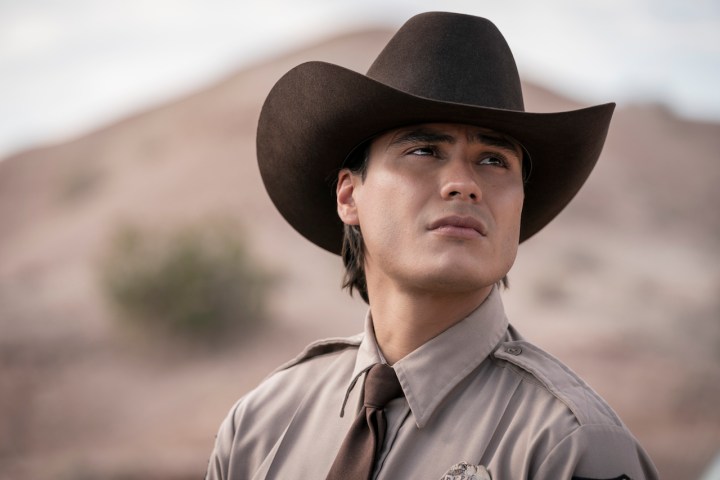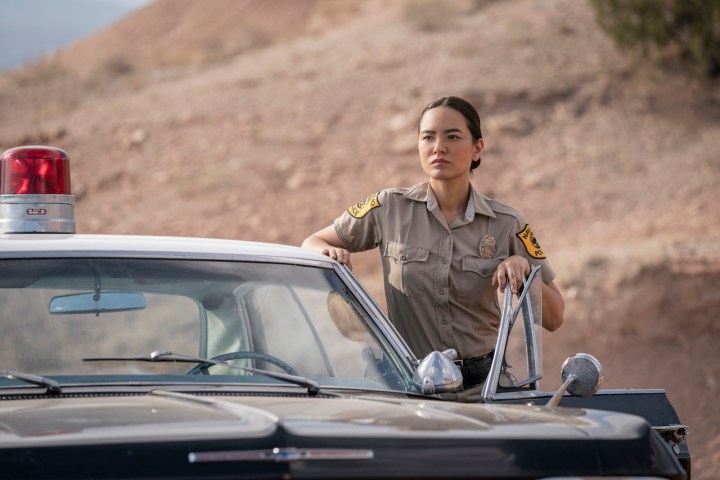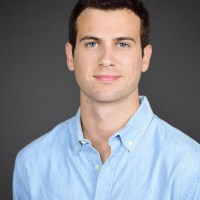Within the first ten minutes of AMC’s Dark Winds, there is an explosive highway robbery and a devastating double homicide in a motel room. Yet, these two incidents feel relatively small in stature compared to the bigger theme at play, the exploration of Navajo life in the American Southwest. Based on the series of novels by Tony Hillerman, Dark Winds follows the adventures of two Navajo police officers: The veteran Joe Leaphorn, played by the terrific Zahn McClarnon, and the rookie Jim Chee, played by Kiowa Gordon.
Dark Winds features a predominantly indigenous cast and crew that includes writer/creator/executive producer Graham Roland (Jack Ryan) and director/executive producer Chris Eyre, who previously directed the television adaption of Skinwalkers, another novel from Hillerman set in the Leaphorn and Chee universe. In conversation with Digital Trends, Roland and Eyre spoke about the importance of Native American representation, the standout performance from McClarnon, and their working relationship with fellow producers Robert Redford and George R.R. Martin.

Note: This interview has been edited for length and clarity.
Digital Trends: Dark Winds was filmed in sovereign nations. It was written, directed, and produced by many Native people. It was shot by a crew that was predominantly Native American. How important was it for indigenous people to tell this story?
Chris Eyre: For me, it was everything to have that air of authenticity to it because point of view is so important to storytelling. And I think that audiences appreciate seeing it from a point of view that it could be in. In novels, it’s young adult fare. With gay and lesbian films, it might be that point of view or [from] female directors. Point of view is everything. It’s been kind of strange that Native people haven’t governed their own voice in mass media for this time, 120 years of film and television. So it’s long overdue.
Shows like Reservation Dogs, Rutherford Falls, and Dark Winds provide the audience with the authenticity that they want and the realism that they want. That’s invoked and seen throughout the subtleties of the show because they’re not things that we need to objectify, as our characters don’t objectify. When Bernadette smudges herself after she leaves the Growing Thunder house, it’s almost an inside job. I think a non-native director might really treat as heroic the culture of it. But to me, this is just the visual, you know, point of view that she’s seeing it from. And it’s not romanticized as much as it’s practical and utilitarian for the people that embody that world. The point of view is everything. It’s just refreshing that we’re in a time and place that we can have a point of view and share it with the world.
In its simplest form, Dark Winds is a crime drama. Toward the beginning of the first episode, Zahn’s character, Joe Leaphorn, investigates the double homicide at the motel. It’s pretty graphic. What were the discussions in terms of how to shoot this scene and decide on what to show and not show?
Eyre: I think Graham’s screenplay, and the way that we made this, I would call it very measured in an informed way. There are subtleties. So when you say it’s really graphic, the old man, Hosteen Tso, is killed in the Big Rock Motel and the contrast is kind of gruesome. But the next person in this crime mystery, Anna, who is also deceased, it’s not gruesome at all. It’s more angelic. And so I think that there’s this duality paradox, the contrast throughout the series. It’s about those degrees of subtlety in the screenplay that we like to evoke throughout the series, [which] is the contrast and the subtlety of how we play certain things visually in brutal ways.

The murder almost serves as the key to opening the door to the rest of the show, an exploration of indigenous life. The audience gets to explore the Native American lifestyle, a lifestyle that some people know nothing about. How were you able to balance the crime storyline along with showcasing Native American culture?
Graham Roland: I think that’s the beautiful thing about television. If we had tried, and Chris knows this because he made two movies, to take one of these books and distill it into 2 hours, you end up with a very plot-driven story. You don’t have a lot of time to go home with these characters. And maybe, like you’re saying, [you] see experienced life through their point of view outside of “the case,” or the mystery. But in a television show, we’re afforded that. We can go home with these characters. And also, in the books, they’re very much, not all of them, some of them do take on multiple points of view, but you’re allowed to deviate from the main characters and go with a character like Emma and have a scene with her. You get more of a big sort of swath of life on the reservation as opposed to just what it’s like to be a police officer investigating a crime.
Was it challenging to condense Dark Winds into six episodes? At some point, did you ever think you need more time to tell this story?
Roland: Yeah. As a writer, I mean we probably could have done a couple more episodes, but I don’t think it was challenging in the sense that we ever felt like it wasn’t enough. You know, we essentially made, what Chris, a three-and-a-half-hour, four-hour movie?
Eyre: Yeah I would I would say a four-hour movie at least if you added it up. And that’s the way I think of it, too. We’re making something of cinema because it lends itself to the West and the Western and John Ford and, you know, Zahn and his cowboy hat. These moral issues in the community. It feels like cinema to me, and we called it a Native American South Western film noir because it fits all these categories that were familiar to people of our time. Because we all grew up before streaming and before DVDs and VHS and like literally, the Western was still from the ’40s and ’50s. It was still such a tenet of our reality of what we consumed. So there’s love. It’s a real love for what we’re seeing, which is the southwest and the Western and the film noir.
The show has a very strong cast with Zahn, Kiowa, Jessica Matten, and the rest of the ensemble. But the show is placed on Zahn’s back. It’s a standout performance. Did you have a moment when you realized that Zahn was the right guy to lead the show?
Roland: I don’t think there was ever any other guy. Right, Chris? We were all familiar with Zahn’s work. I don’t even think there was another name that ever came up.
Eyre: We discussed it internally, and Zahn’s name was at the top of the list, and nothing ever displaced that. We just went to Zahn and said, “Hey, we want you to take a look and join the team if you feel it.” And he came back and wanted to be our pitcher, our star pitcher.

How has it been having Robert Redford back this project?
Eyre: You know, it’s ironic, and I keep using the word irony with this project because Native Americans have been seen as invisible. That’s ironic right there. Native Americans have been seen as invisible. They’ve also been seen as these spiritual forces so this paradox is the same thing in all these conversations about Dark Winds. And maybe that’s the thing I’m most proud of, [which] is the elusiveness of what we’re trying to articulate sometimes because it’s apropos of life. These are characters going through their own experiences and sometimes, it’s not black or white; it’s gray. I think Leaphorn wears that. Leaphorn wears this life experience on his shoulder, but he gets up every day, and he tries to do better. And there’s something about that morality and that compass that I think we all understand and appreciate.
And so for the relationship we have with Redford in this project, it’s a paradox again. George [R.R. Martin] and Bob are both legends, and they just want to see good stories being told. They want to support the Native American community and the vision that we had. Again, the irony is that I sat there with George and Bob one day once we weren’t able to make this at another streamer, and we didn’t have a home with George and Bob attached. As we were sitting there debating what to do, I think it was George who said, “This is a tough industry,” shaking his head. That’s the guy who created Game of Thrones [laughter]. You think that’s a slam dunk. And Bob looked back at him and said, “You’re damn right it’s a tough industry.” And I could hear the decades of knowledge in that sentence. “You’re damn right.”
That’s the irony. It takes so many people to be focused on the same thing. Even with people like Bob and George and their humbleness, I just appreciate the fact that they were there to support us. That’s kind of what it’s all about. It’s about giving what you can, and they both gave their names and expertise to us and let us lead the way.
Dark Winds airs Sundays at 9 pm ET/PT on AMC, and is available to stream on AMC+.



